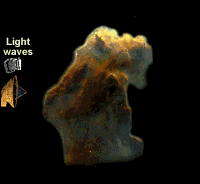SETI Game
Our colleagues at The SETI Institute have recently added an interesting educational SETI Game area to their web site. What
follows is a response to their comparisons of the efficacies of the radio and optical
approach to SETI. There is a game here within the game which involves the SETI
Institute regularly putting out arguments against Optical SETI and yours truly responding
with counter-arguments. I have made extensive use of the images that the SETI
Institute has deployed on their "game" pages. Let the fun continue!
See also The Politics of SETI and Book
Reviews.
| This image of NGC 2997 looks something like our
own Milky Way galaxy. The solar system is situated some about 30,000 light years
from the center of our galaxy. The Milky Way galaxy is about 100,000 light years in
diameter. |
 |
 |
Our nearest galactic neighbor is the famous
Andromeda (M31) galaxy, which is located some 2.2 million light years from the Milky Way.
The distance is so vast and signal propagation times so long at light-speed (3 x 108
meters per second), that few people would think it worthwhile to attempt to establish
SETI-type communications between galaxies using electromagnetic technology of any form.
Any species that attempts to do that is probably not very intelligent!
However, SETI-type communications over interstellar distances is quite a different
question, and one-way or two-way communications between nearby stars, even as slow
as light-speed, is something that could reasonably be contemplated. As the
interstellar distances increase, the issue becomes more problematic, just because of the
time required for responsive communications. |

 |
If you click on this image, details about the
optical spectrum from the ultra-violet to the infrared will be revealed. |
 |
Part of this animated gif "borrowed"
from the SETI Institute web site consists of the famous image of the "Gaseous
Pillars". This wonderful image of the Eagle Nebula (M16), the birthplace of
stars, was captured by the Hubble Space Telescope in late 1995. It has even been
featured in the background of Star Trek Voyager and in Babylon 5, such is its
beauty. An image of these Gaseous Pillars has existed on the COSETI web site since
this new, larger consolidated web site was activated in August 1997. Click on the
image to the left to see it in all its glory. M16 is located about 7,000 light years
from the earth. The animated gif illustrates the severe attention of laser light that
would occur if ETIs attempted to transmit a laser beacon through the cloud of gas and
dust, while at the same time showing that microwaves can penetrate the cloud easily.
But that is not the whole story! |



Version 1.0
March 16, 1998
|
![]()